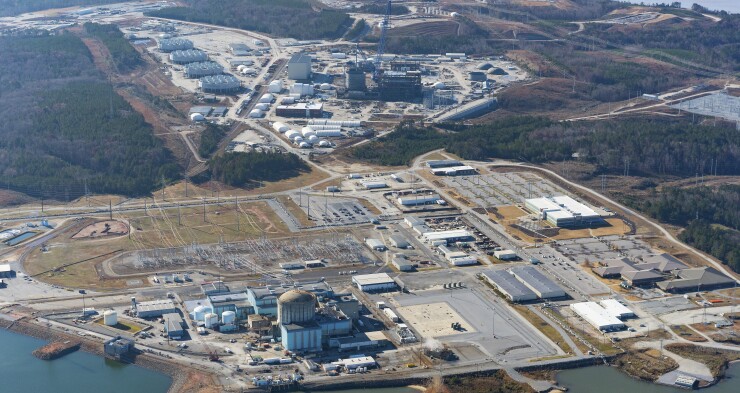By mid-March, South Carolina-owned Santee Cooper’s destiny finally may be known after encountering more than two years of political and public turmoil from a decision that left the utility with $4 billion in debt and no asset to support it.
The state Department of Administration has released a report analyzing proposals the agency and its consultants received from investor-owned utilities offering to manage Santee Cooper and to buy it.

DOA consultants also scrutinized the 449-page “Santee Cooper Reform Plan” proposed by the utility, known formally as the South Carolina Public Service Authority.
From 10 bids received, consultants recommended that the General Assembly consider a management plan submitted by Richmond, Virginia-based Dominion Energy Inc., and a purchase proposal by Juno Beach, Florida-based NextEra Energy, the parent of Florida Power & Light Co.
“The Reform Plan provides for improved governance and substantial savings, and the Dominion management proposal and the NextEra sale bid provide alternatives worthy of consideration by the General Assembly and the governor,” the 111-page DOA report released Feb. 11 concludes.
Gov. Henry McMaster, a vocal proponent of selling the state’s largest public power utility since it terminated work in July 2017 on two unfinished nuclear reactors, issued a statement shortly after the DOA report was released.
“Ratepayers will either continue paying for two reactors which were never built, or they will get back what they’ve already paid,” McMaster said. “Our state will either gain a vibrant new addition to our economic prosperity, or will remain stagnated in the status quo. The politics of indecision is unacceptable. The time to act is now.”
State lawmakers will hold hearings to consider the report and its options. At a joint meeting of the Senate Finance and House Ways and Means Committee Feb. 13, Marcia Adams, the DOA’s executive director, and consultants reviewed the agency’s report.
In a public presentation on the Reform Plan the next day that was webcast, a Santee Cooper board member took issue with a statement he said consultants made to lawmakers saying that the utility has a “broken culture.”
“We had leadership issues and failures,” the board member said. “We’re addressing those.”
In a notice to investors, Santee Cooper said the DOA report was delivered to the Senate Finance Committee and the House Ways and Means Committee, including the authority’s own “proposal to remain an ongoing, self-managed entity.”
The committees are required to make a recommendation to the President of the Senate and the Speaker of the House within 30 days, the Feb. 12 notice on the Municipal Securities Rulemaking Board’s EMMA filing system said. Santee Cooper provided a link to its website where the plan, a related handout and press release can be found.
While Santee Cooper cooperated with DOA consultants providing documentation and negotiating changes in the Reform Plan, investors were told that the utility didn’t participate in writing the report.
“As a result, we are not currently able to discuss the DOA report or matters related thereto on a one-on-one basis with investors and accordingly we will not be accepting investor calls at this time,” the notice said, adding that an investor communication on the plan’s key components is expected to be released the week of Feb. 24.
Santee Cooper — on its website, in its Reform Plan, and again at the authority’s Feb. 14 meeting — apologized for its role in discontinuing construction on the two partially built reactors at the V.C. Summer Nuclear Power Station near Jenkinsville, South Carolina. Santee Cooper issued $4 billion of bonds to finance its 45% ownership share in the failed project, a point that has created political and public tension for two and a half years.
“We do shoulder our share of the blame” for shutting down work on the V.C. Summer reactor units 2 and 3, Santee Cooper President Mark Bonsall said at the authority’s meeting, apologizing “for that cancellation.”
The reactor project for a host of reasons needed to be brought to an end, he said, adding that “needless to say such a large cancellation led to public and political outcry that was and is justifiable.”
The Reform Plan, he said, is a way to “make it up” to ratepayers and the state.
Bonsall, hired as Santee Cooper’s president and chief executive officer in July 2019 to reinvent the agency in an effort to convince lawmakers that it is a valuable asset that the state should retain, said in a press release that the Reform Plan emphasizes transparency, risk management, price and service stability.
“It also keeps all the benefits South Carolina realizes from a state-based electric utility, such as economic development and environmental stewardship, and it keeps control of that utility local. It is a very certain path forward,” he said.
Santee Cooper said it will transform itself into a “leaner, greener” power supply agency focusing more on solar generation, new battery storage, closing coal-fired plants, adding natural gas capacity, and new conservation programs. All are aimed at producing net present value savings of $2.7 billion over 20 years that will help pay off debt and provide price stability for customers for at least seven years.
The utility expects to cut 300 jobs over a decade, most, if not all, through retirements and attrition.
More aggressive pay down of debt will stabilize rates for seven years. Some $3.6 billion will be paid off in 12 years, “equal” to the outstanding nuclear debt, Bonsall said. The debt ratio is expected to reach a “historic low” of 68% by 2026. The plan will provide 12 years of price stability to the Central Electric Power Cooperative, Santee Cooper’s largest customer.
The plan will also include improved transparency and accountability, adding a series of checks and balances and public hearings to operations and siting plans, including an offer to allow the South Carolina Public Service Commission to settle siting disputes between Santee Cooper and the state Office of Regulatory staff.
The DOA report said Santee Cooper’s Reform Plan doesn’t “provide a roadmap to resolve the Cook litigation. Consequently, it remains a potential financial risk for ratepayers or taxpayers.”
The Jessica S. Cook class-action lawsuit is a complicated ongoing massive case that involves numerous parties and cross claims, and Santee Cooper typically doesn’t comment on pending legal matters.
The suit is over $9 billion in fees charged by Santee Cooper and South Carolina Electric & Gas. SCE&G, an investor owned utility, had a 55% share in the doomed project and merged with Dominion Energy on Jan. 1, 2019, a move that brought Dominion into the Cook case.
In November, Santee Cooper issued a rare press release saying that it opposed a tactic by Dominion to remove the Cook case from state to federal court. Dominion had also filed a motion in the case attempting to extract legal costs from Santee Cooper, and filed an arbitration case against Santee Cooper, which was stayed by the court and subsequently withdrawn.
The Cook case is set for trial to begin on April 20.

While the consultants’ report said both the Dominion management proposal and the NextEra sale bid focus on costs over a 20-year period as requested by lawmakers, the report also says the initial term of Dominion’s plan would be 10 years and that it can be terminated in the event a change in control occurs by either party.
The Dominion proposal consists of placing three or more company employees at Santee Cooper to fill key management roles, and potentially the post of chief executive officer. A management fee wouldn’t be charged but placed employees would be reimbursed for costs, which were not revealed.
Dominion doesn’t contemplate changes in the workforce, and Santee Cooper would retain its tax-exempt borrowing power. Consultants also negotiated the removal of a requirement that Santee Cooper indemnify Dominion was removed. It also doesn’t address the Cook litigation and it would remain “a potential financial risk for ratepayers or taxpayers.”
NextEra wants to buy Santee Cooper, a plan that terminates the authority’s tax-exempt status, pays off $6.9 billion of debt, provide $400 million in rate relief for customers and includes a rate freeze for four years.
The bid to purchase Santee Cooper includes cutting more than 700 jobs over the next decade and providing $540 million to customers, an amount intended to settle the Cook lawsuit. The lawsuit, however, seeks billions in recompense for the nuclear debacle. As a privately held company, NextEra would have to pay taxes and fees to the state.
The NextEra bid doesn’t assume Santee Cooper’s existing pension liabilities and liabilities related to the other post-employment benefits trust for active or inactive employees. Those liabilities, estimated at $525 million, would shift to the state.
Lawmakers passed a joint resolution last year ordering the DOA to get competitive bids for selling and managing Santee Cooper, after being unable to reach a conclusion about the utility’s fate legislatively. Santee Cooper was ordered to pay DOA at least $15 million to hire consultants to evaluate the proposals that may end of leading to its own demise as a public utility the state has owned for 86 years.
DOA hired financial advisor Moelis & Co., legal advisor Gibson, Dunn and Crutcher LLP, and market advisor Energy + Environmental Economics, which provided utility policy consulting services.
While the consultants analyzed Santee Cooper’s Reform Plan and spoke about the benefits to be achieved, they made negative statements about the utility.
“The situation at Santee Cooper that led to the joint resolution resulted from decisions that, in the view of the professional service experts, are attributable in part to a lack of third-party oversight of, and accountability by, Santee Cooper,” the report said.
It touted that consultants worked with Santee Cooper to obtain improvements in the Reform Plan such as board member term limits and qualification requirements; forming a resource planning group; hiring technical advisors; and increasing transparency, including public hearings on pricing and major projects in which the Office of Regulatory Staff can intervene.
“In no small part, shortcomings in Santee Cooper’s management, structure, and culture were the root cause for the state’s current problem, and while some changes have been made, these issues remain,” the report’s executive summary said.
Santee Cooper’s plan should adequately address fundamental, structural changes for prudent overight and governance; express a management philosophy that mitigates the impact on ratepayers of outstanding debt for assets neither used nor useful, while lowering costs; and it should exemplify “a culture shift” that can solve the fractured relationship and restore the confidence of the Central co-op, the report said.





